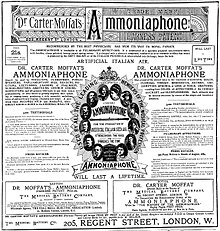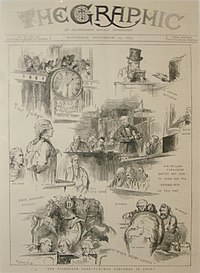The Graphic was a British weekly illustrated newspaper, first published on 4 December 1869 by William Luson Thomas's company Illustrated Newspapers Ltd. Thomas's brother Lewis Samuel Thomas was a co-founder. The premature death of the latter in 1872 "as one of the founders of this newspaper, [and who] took an active interest in its management" left a marked gap in the early history of the publication.[1] It was set up as a rival to the popular Illustrated London News.
The influence of The Graphic within the art world was immense, its many admirers included Vincent van Gogh, and Hubert von Herkomer.[2]
It continued to be published weekly under this title until 23 April 1932 and then changed title to The National Graphicbetween 28 April and 14 July 1932; it then ceased publication, after 3,266 issues. From 1890 until 1926, Luson Thomas's company, H. R. Baines & Co., published The Daily Graphic.
Background[edit]
The Graphic was founded by William Luson Thomas, a successful artist, wood-engraver and social reformer. Earlier he, his brother and his brother-in-law had been persuaded to go to New York and assist in launching two newspapers, Picture Gallery and Republic. Thomas also had an engraving establishment of his own and, aided by a large staff, illustrated and engraved numerous standard works.[3] Exasperated, even angered, by the unsympathetic treatment of artists by the world's most successful illustrated paper, The Illustrated London News, and having a good business sense Luson Thomas resolved to set up an opposition. His illustrated paper, despite being more expensive than its competition, became an immediate success.[2]
Realisation[edit]
When it began in 1869, the newspaper was printed in a rented house. By 1882, the company owned three buildings and twenty printing presses, and employed more than 1,000 people. The first editor was Henry Sutherland Edwards. A successful artist himself, the founder Thomas recruited gifted artists including Luke Fildes, Hubert von Herkomer, Frank Holl, and John Everett Millais.
The Graphic was published on a Saturday and its original cover price was sixpence, while the Illustrated London News was fivepence.[2] In its first year, it described itself to advertisers as "a superior illustrated weekly newspaper, containing twenty-four pages imperial folio, printed on fine toned paper of beautiful quality, made expressly for the purpose and admirably adapted for the display of engravings".
In addition to its home market the paper had subscribers all around the British Empire and North America. The Graphic covered home news and news from around the Empire, and devoted much attention to literature, arts, sciences, the fashionable world, sport, music and opera. Royal occasions and national celebrations and ceremonials were also given prominent coverage.
Artists[edit]
Artists employed on The Graphic and The Daily Graphic at the end of the 19th century and beginning of the 20th century included Helen Allingham, Edmund Blampied, Alexander Boyd, Frank Brangwyn, Randolph Caldecott, Lance Calkin Léon Daviel, John Charles Dollman, James H. Dowd, Godefroy Durand, Luke Fildes, Harry Furniss, John Percival Gülich, George du Maurier, Phil May, George Percy Jacomb-Hood, Ernest Prater, Leonard Raven-Hill, Sidney Sime, Snaffles (Charles Johnson Payne), George Stampa, Edmund Sullivan, Bert Thomas, F. H. Townsend, Harrison Weir, and Henry Woods.
The notable illustrator Henry William Brewer, contributed a regular illustrated article on architecture to the magazine for 25 years, until his death in 1903.[4][5]
Writers[edit]
Writers for the paper included George Eliot, Thomas Hardy, H. Rider Haggard and Anthony Trollope.[6] Malcolm Charles Salaman was employed there from 1890 to 1899. Beatrice Grimshaw travelled the South Pacific reporting on her experiences for the Daily Graphic.[7] Mary Frances Billington served the Graphic as a special correspondent from 1890 to 1897, reporting from India in essays that were compiled into Woman in India (1895).[8] Joseph Ashby-Sterry wrote the Bystander column for the paper for 18 years.
Nile Expedition
This article needs additional citations for verification. (January 2008) |

The Nile Expedition, sometimes called the Gordon Relief Expedition (1884–1885), was a British mission to relieve Major-General Charles George Gordon at Khartoum, Sudan. Gordon had been sent to Sudan to help the Egyptians withdraw their garrisons after the British decided to abandon Sudan in the face of a rebellion led by self-proclaimed Mahdi, Mahommed Ahmed. A contingent of Canadians was recruited to help the British navigate their small boats up the Nile River. The Nile Expedition was the first overseas expedition by Canadians in a British imperial conflict, although the Nile Voyageurs were civilian employees and did not wear uniforms.

The expedition was commanded by Garnet Wolseley. After Commander Herbert Stewart was mortally wounded, Brigadier-General Charles William Wilson took command of an advance party of about 1,400 men. A small part of Wilson's Desert Column reached Khartoum on two Nile steamers in the afternoon of 28 January 1885. It came two days too late: Khartoum had been seized by the Mahdists in the early hours of 26 January. The entire garrison, along with Gordon and 4,000 civilians had been killed.[1]
Wilson received criticism afterwards for his delay in sailing to Khartoum, with Wolseley stating that Wilson had "lost any nerve he had ever possessed".[2] Other sources however, spread the blame, particularly on Wolseley.[3]The public in England also blamed Prime Minister William Gladstone for not having taken steps to relieve the siege of Khartoum and some historians have held Major-General Gordon responsible, because he had refused the order to evacuate while it was still possible.[4]
Ammoniaphone
Ammoniaphone was a voice improvement device invented by Dr. Carter Moffat. It was introduced in 1886.[1]
Background.

Moffat thought that the explanation that so many good singers came from Italy must have something to do with the air. When given the opportunity to travel to Italy (according to a newspaper clipping to solve a chemical problem of industrial importance – an assignment he completed so successfully that he was awarded a diploma of honor and a gold medal by the Italian government) he set about testing the air in Italy to reveal its secrets. He discovered that, along with traces of essential oils from herbs, Italian air contained considerable amounts of "peroxide of hydrogen", and "free ammonia". He then created a device that could reproduce this mixture and administer it in appropriate doses.
Ammoniaphone M812 is on permanent display at the Swedish Museum of Performing Arts / Scenkonstmuseetand Stiftelsen Musikkulturens Främjande .

